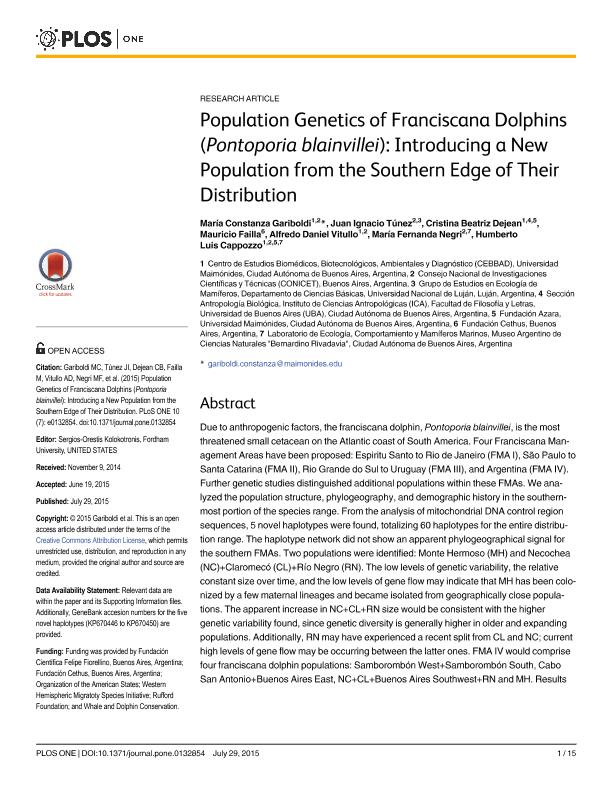Mostrar el registro sencillo del ítem
dc.contributor.author
Gariboldi, María Constanza

dc.contributor.author
Tunez, Juan Ignacio

dc.contributor.author
Dejean, Cristina Beatriz

dc.contributor.author
Failla, Mauricio
dc.contributor.author
Vitullo, Alfredo Daniel

dc.contributor.author
Negri, Maria Fernanda

dc.contributor.author
Cappozzo, Humberto Luis

dc.date.available
2018-04-11T18:36:44Z
dc.date.issued
2015-07
dc.identifier.citation
Gariboldi, María Constanza; Tunez, Juan Ignacio; Dejean, Cristina Beatriz; Failla, Mauricio; Vitullo, Alfredo Daniel; et al.; Population Genetics of Franciscana Dolphins (Pontoporia blainvillei): Introducing a New Population from the Southern Edge of Their Distribution; Public Library of Science; Plos One; 10; 7; 7-2015; 1-15
dc.identifier.issn
1932-6203
dc.identifier.uri
http://hdl.handle.net/11336/41755
dc.description.abstract
Due to anthropogenic factors, the franciscana dolphin, Pontoporia blainvillei, is the most threatened small cetacean on the Atlantic coast of South America. Four Franciscana Management Areas have been proposed: Espiritu Santo to Rio de Janeiro (FMA I), São Paulo to Santa Catarina (FMA II), Rio Grande do Sul to Uruguay (FMA III), and Argentina (FMA IV). Further genetic studies distinguished additional populations within these FMAs. We analyzed the population structure, phylogeography, and demographic history in the southernmost portion of the species range. From the analysis of mitochondrial DNA control region sequences, 5 novel haplotypes were found, totalizing 60 haplotypes for the entire distribution range. The haplotype network did not show an apparent phylogeographical signal for the southern FMAs. Two populations were identified: Monte Hermoso (MH) and Necochea (NC)+Claromecó (CL)+Río Negro (RN). The low levels of genetic variability, the relative constant size over time, and the low levels of gene flow may indicate that MH has been colonized by a few maternal lineages and became isolated from geographically close populations. The apparent increase in NC+CL+RN size would be consistent with the higher genetic variability found, since genetic diversity is generally higher in older and expanding populations. Additionally, RN may have experienced a recent split from CL and NC; current high levels of gene flow may be occurring between the latter ones. FMA IV would comprise four franciscana dolphin populations: Samborombón West+Samborombón South, Cabo San Antonio+Buenos Aires East, NC+CL+Buenos Aires Southwest+RN and MH. Results achieved in this study need to be taken into account in order to ensure the long-term survival of the species.
dc.format
application/pdf
dc.language.iso
eng
dc.publisher
Public Library of Science

dc.rights
info:eu-repo/semantics/openAccess
dc.rights.uri
https://creativecommons.org/licenses/by-nc-sa/2.5/ar/
dc.subject
Dolphins
dc.subject
Mitochondrial Dna
dc.subject
Haplotypes
dc.subject
Phylogeography
dc.subject.classification
Otras Ciencias Biológicas

dc.subject.classification
Ciencias Biológicas

dc.subject.classification
CIENCIAS NATURALES Y EXACTAS

dc.title
Population Genetics of Franciscana Dolphins (Pontoporia blainvillei): Introducing a New Population from the Southern Edge of Their Distribution
dc.type
info:eu-repo/semantics/article
dc.type
info:ar-repo/semantics/artículo
dc.type
info:eu-repo/semantics/publishedVersion
dc.date.updated
2018-04-11T15:12:33Z
dc.journal.volume
10
dc.journal.number
7
dc.journal.pagination
1-15
dc.journal.pais
Estados Unidos

dc.journal.ciudad
San Francisco
dc.description.fil
Fil: Gariboldi, María Constanza. Consejo Nacional de Investigaciones Científicas y Técnicas; Argentina. Universidad Maimónides. Área de Investigaciones Biomédicas y Biotecnológicas. Centro de Estudios Biomédicos, Biotecnológicos, Ambientales y de Diagnóstico; Argentina
dc.description.fil
Fil: Tunez, Juan Ignacio. Consejo Nacional de Investigaciones Científicas y Técnicas; Argentina. Universidad Nacional de Luján; Argentina
dc.description.fil
Fil: Dejean, Cristina Beatriz. Universidad Maimónides. Área de Investigaciones Biomédicas y Biotecnológicas. Centro de Estudios Biomédicos, Biotecnológicos, Ambientales y de Diagnóstico; Argentina. Universidad de Buenos Aires. Facultad de Filosofía y Letras. Instituto de Ciencias Antropológicas. Sección Antropología Biológica; Argentina
dc.description.fil
Fil: Failla, Mauricio. Fundación Cethus; Argentina
dc.description.fil
Fil: Vitullo, Alfredo Daniel. Consejo Nacional de Investigaciones Científicas y Técnicas; Argentina. Universidad Maimónides. Área de Investigaciones Biomédicas y Biotecnológicas. Centro de Estudios Biomédicos, Biotecnológicos, Ambientales y de Diagnóstico; Argentina
dc.description.fil
Fil: Negri, Maria Fernanda. Consejo Nacional de Investigaciones Científicas y Técnicas; Argentina. Consejo Nacional de Investigaciones Científicas y Técnicas. Oficina de Coordinación Administrativa Parque Centenario. Museo Argentino de Ciencias Naturales ; Argentina
dc.description.fil
Fil: Cappozzo, Humberto Luis. Consejo Nacional de Investigaciones Científicas y Técnicas; Argentina. Universidad Maimónides. Área de Investigaciones Biomédicas y Biotecnológicas. Centro de Estudios Biomédicos, Biotecnológicos, Ambientales y de Diagnóstico; Argentina. Consejo Nacional de Investigaciones Científicas y Técnicas. Oficina de Coordinación Administrativa Parque Centenario. Museo Argentino de Ciencias Naturales ; Argentina
dc.journal.title
Plos One

dc.relation.alternativeid
info:eu-repo/semantics/altIdentifier/doi/https://dx.doi.org/10.1371/journal.pone.0132854
dc.relation.alternativeid
info:eu-repo/semantics/altIdentifier/url/http://journals.plos.org/plosone/article?id=10.1371/journal.pone.0132854
Archivos asociados
